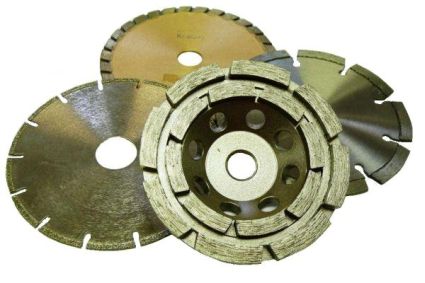 In either case, knowing specification details and how they relate to tool performance is the best foundation that shoppers can have when matching diamond abrasives to their work.
Technical know-how helps tool users make the best purchasing decisions, regardless of how products are labeled and advertised by manufacturers.
In either case, knowing specification details and how they relate to tool performance is the best foundation that shoppers can have when matching diamond abrasives to their work.
Technical know-how helps tool users make the best purchasing decisions, regardless of how products are labeled and advertised by manufacturers.
Diamond abrasives are made by adhering diamond particles to a base material with a bonding agent. Sometimes the bonding agent also serves as the "base" of the product, and other times they are separate. Qualities related to this basic construction can drastically alter the product's performance, and are discussed below.
Because diamond abrasives are expensive, most purchasing guidelines for them aim to maximize cost efficiency. This is done by correctly matching a diamond product's durability to the kind of cutting it will be ding and the target material it will be cutting.
Bond Types
Understanding the importance of bond type and bond hardness (discussed below) in diamond abrasives requires knowing how they wear and stay sharp.
Simply, (with the exception of "dressing") they stay sharp by wearing.
Friction, pressure, and heat during use causes dull, top-layer diamonds to pop out of the bond matrix, exposing fresh, sharp diamonds beneath.
The rate at which diamond abrasives wear/self-sharpen depends on a balance between material hardness and the strength of the bond holding the diamonds in place. The idea is to use blades that wear at a rate that replaces diamonds just as they begin to dull, maximizing the quality cutting, cutting speed, and their durability.
There are three major bonding types used to manufacture diamond abrasives: metal matrix (sintered), resin, and electroplated.
Sintered/Metal Bonded
Metal bonded diamond abrasives are the most commonly used, because, generally speaking, they are the most durable and very general purpose.
Diamond grains are bonded to a metal matrix in a sintering process (heat and pressure) that layers diamond grains throughout the material. Sometimes this diamond/metal matrix is bonded to a separate base (usually steel), and sometimes the matrix also serves as the base.
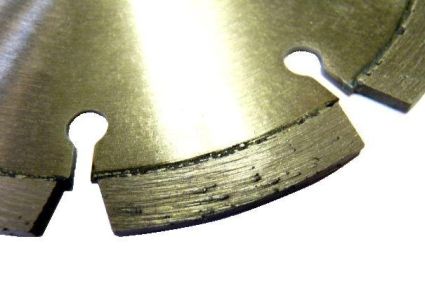 Because of their durability, metal bonded diamond abrasives are the most cost effective unless the specialization of resin or nickel bond types is needed.
Because of their durability, metal bonded diamond abrasives are the most cost effective unless the specialization of resin or nickel bond types is needed.
Although this bond type is generally "universal," metal bonded abrasives still vary between one another in terms of hardness and other factors, and need to be carefully matched to their applications.
- Most common metal bond grades (bond hardness): L, N (most common of the two)
- dressable
- the most durable and universal
Resin
Construction of diamond abrasives using resin as a bonding material is very similar to the construction of non-diamond grinding wheels that use a resin agent.
Resin is a much softer bonding agent than metal matrix, and allows diamond particles to escape the product more readily. This means that resin bonded diamond abrasives do better at staying sharp than metal bond types, cut and remove material faster, are cooler cutting, are "dressable," and great for precision grinding and cutting.
The disadvantage is that resin abrasives will wear much faster. One, this restricts their use to materials in the soft to medium range.
Two, their lower durability means that it's even more important to select the right resin bond hardness for the target material. Otherwise, users will be going through products too quickly for the benefits of resin bonded diamond products to be cost effective.
- Most common resin bond grades (hardness): H, N, R
- dressable
- fast, cool cutting for precision work and finishing
Electroplated diamond products use a thin sheet of nickel to bond a single layer of diamonds to the product (usually blades).
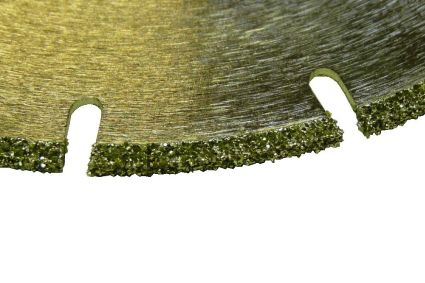 This bond type is soft and wears very rapidly, is not dressable, should be restricted to softer materials, and is usually only cost effective for minimal use.
This bond type is soft and wears very rapidly, is not dressable, should be restricted to softer materials, and is usually only cost effective for minimal use.
The advantages to this bond type are that nickel bonded diamond products are very abrasive and fast cutting. They can also be stripped and re-plated at minimal cost to the owner.
- Most common nickel bond grades: N, P, R
- not dressable, but can be stripped and replated
- maximum particle exposure, and high stock removal
Correctly estimating the needed durability of a diamond abrasive is the most important purchasing consideration, because of their expense.
Bond hardness (along with bond type) is the most determining factor for durability, and must be matched correctly to material hardness. The general guidelines are these:
1. Softer bonds for harder application materials.
- Harder materials will wear (dull) diamond particles faster.
- This means that, in order for the product to stay sharp, a softer bonding agent is needed to allow diamond grains to escape the matrix more rapidly.
- Too hard a bond will cause very slow cutting, and risk heat damage to the abrasive.
- Softer materials will not wear diamond particles as quickly.
- This means that particles are usable in the abrasive longer, and do not need to be ejected from the bonding matrix as rapidly in order to ensure efficient cutting.
- Too soft a bonding material will cause unnecessary wear, because still-sharp diamond grains will leave the product prematurely.
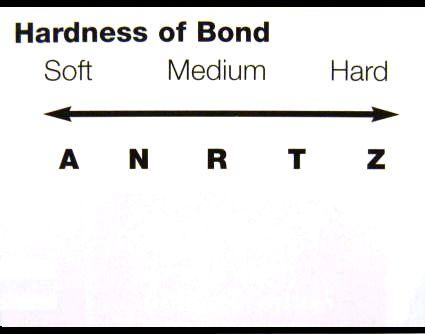
Again, it is important to mention that shoppers will still have to choose a specific bond hardness, even between diamond abrasives of the same bonding type.
[Back to top]
Diamond Grit Size (Mesh Size)
A specialized mesh is used during the manufacturing process of diamond abrasives, serving two purposes:
1. The mesh sorts diamond grit sizes within a specific range, and
2. It positions the diamond grains for bonding.
- Because of this, "mesh size" and "grit size" are interchangeable terms when talking about diamond abrasives.
Diamond abrasives aren't always labeled with their exact grit number, sometimes advertised as simply being of coarse, medium, or fine grit. Below are the grit number ranges that generally make up these categories:
Coarse: 20-80; (masonry, concrete, and stone)
Medium: 80-200; (glass, ceramics, and quarts)
Fine: 200-400; (slow grinding, and fine polishing)
[Back to top]
Diamond Concentration
The concentration of diamond grains in their bond matrix can be altered in diamond abrasives to achieve different effects in performance.
Concentration is expressed much like grit size, using a system of "round" numbers that represent specific volumetric distributions of diamond grains. For example, concentration number 100 is typical for diamond abrasive products, and it corresponds to an exact measurement of 4.4 carats (of diamonds) per cubic centimeter, or, 25% concentration of diamonds by volume in the bonding matrix.
The chart below offers a few examples of diamond concentration conversions:
Diamond Concentration Conversion Chart
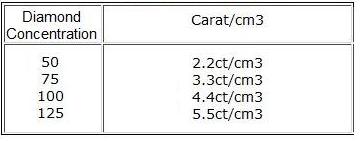 General guidelines about diamond concentration:
General guidelines about diamond concentration:
- Higher concentration will make blades more durable and produce a finer finish, but it will also cause slower cutting speeds because of increased friction.
- Abrasives with a lower diamond concentration are generally better for hard materials, and they cut much faster.
Just like diamonds that are used in jewelry, abrasive diamonds come in many types and grades.
The nomenclature and categorizing systems for these features are excessively technical, extensive, and often confusing. Changes in diamond type and grade do affect diamond abrasives, but only in a secondary way when compared to the other, more critical, features and design differences discussed in this article.
Because of the depths of these topics and their relative unimportance, we won't delve any further into the subject. However, we make this brief mention to acknowledge that shoppers will eventually encounter these terms, and invite them to investigate diamond grades and types if their applications demand it.
[Back to top] Conclusion
Need to find that perfect diamond abrasive? Visit our Diamond Abrasives page to browse through our huge selection of diamond blades, diamond cups, and diamond core bits.
Remember, shopping with durability and cost-effectiveness in mind is the way to go with diamond abrasives. The hardness of the bond and other product features must be balanced with material hardness and the type of work being done.
To help make the search easier, shoppers visiting eReplacementParts.com can narrow diamond abrasive searches by selecting what kind of target material they have in mind. This way, the only products that display on the page are those that combine features for the selected application material.
[Back to top] What we're about.

